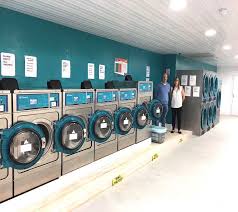Starting Strong in the Laundry Game — But Are You Missing These Crucial Steps?
It’s easy to think running a laundry route is just a matter of collecting dirty linen and returning it clean. But ask anyone who’s been in the industry for more than five minutes, and they’ll tell you: what separates the successful operators from the overwhelmed ones comes down to smart Laundry Room Management.
Whether you’re delivering to gyms, short-stay rentals, or aged care centres, the difference between a well-oiled operation and a mess of missed pick-ups usually lies in planning and consistency. Here are some of the biggest mistakes new laundry route operators make—and how to avoid them before they damage your business.
Mistake #1: Underestimating the Importance of Scheduling
Skipping structured pick-up and drop-off times is one of the fastest ways to lose clients. If they’re relying on towels or sheets for their day-to-day operations, they can’t afford unpredictability.
Instead of offering vague windows, use a delivery calendar system to lock in precise timings. Many successful operators rely on digital scheduling tools or even customised web apps to track runs and alert clients before arrival. This isn’t just convenience—it’s basic professionalism.
Clients will remember the one time you made them wait all morning. They won’t remember the dozen times you were on time.
A well-structured schedule forms the foundation of efficient Laundry Room Management.
Mistake #2: Ignoring Volume Trends
Think of volume forecasting as your secret weapon. If you’re not tracking how much laundry each location generates week-to-week, you’re flying blind.
Too many new operators end up with overflowing vans one day and half-empty ones the next. This leads to delays, fuel waste, and missed revenue opportunities.
- Use simple spreadsheets or route tracking software to monitor trends.
- Offer clients a quick online form to request extra pick-ups.
- Track seasonal changes—for example, fitness centres might double usage during January.
These volume insights allow you to scale up or down as needed, improving turnaround time and cutting operational bloat.
Good route operators move laundry. Great ones predict it.
Mistake #3: Treating Every Client the Same
A gym doesn’t care about fitted sheets. An Airbnb host doesn’t need 50 hand towels a day. Yet some operators set up blanket service packages that don’t reflect actual use.
The smarter move? Create service tiers based on business type. This isn’t about “customisation”—it’s just practical.
- Spas want immaculate white towels, fast turnaround, and stain removal.
- Hotels value punctuality, weekend service, and backup stock.
- Medical clients require strict separation between different wash types.
Proper Laundry Room Management means adjusting processes to match client needs. It’s not about doing more. It’s about doing what matters most for each client.
Mistake #4: Skimping on Communication
One of the quickest ways to lose a client is radio silence. If there’s a delay, an issue with stock, or a billing concern—say something. Too many route operators make the mistake of “waiting until they know more” before replying.
Clients don’t need the full story—they just want to know they’re not forgotten.
Set up systems that trigger SMS or email updates when:
- A delivery is completed.
- A delay is expected.
- A service note (e.g. “5 towels torn”) is logged.
Overcommunication beats silence, every time.
Communication is the detergent of client trust. It keeps everything fresh.
Mistake #5: Neglecting Equipment Maintenance
It’s not just washers and dryers you need to worry about—it’s your van, too. Nothing throws a schedule off like a flat tyre or a busted washer on a busy day.
Make weekly vehicle checks and monthly machine maintenance non-negotiable. Preventative action saves you from last-minute scrambling.
Additionally, many operators overlook how the layout and organisation of their physical laundry room affects speed. An efficient laundry area with clear sorting stations, folding benches, and airflow can boost throughput and cut staff fatigue.
Here’s a useful breakdown of laundry room layout standards by commercial category: Laundry Facility Design Guide.
Mistake #6: Not Tracking Costs Properly
Fuel. Detergent. Labour. Time. Every stop on your route costs money—but not all clients bring in the same return.
Operators who don’t track profitability by client often find themselves subsidising one customer with another’s revenue. That’s a recipe for burnout.
Basic profit-per-client tracking includes:
- Fuel usage per kilometre.
- Minutes spent on pick-up, wash, and return.
- Staff hours per load.
- Detergent and utilities per job.
Even a quick spreadsheet can help reveal which clients are gold, and which are dragging the operation down.
Tracking financials is an often-missed part of Laundry Room Management, but it can make or break a growing business. (Laundry Room Management)
Mistake #7: Forgetting to Build a Buffer
No, not a financial buffer—though that’s important too. We’re talking time. The rookie mistake? Planning your route with zero flex built in.
Flat tyres, slow elevators, misplaced loads—they happen. If your schedule doesn’t have buffer time, you’ll end up playing catch-up for hours.
A simple rule: schedule 15 minutes extra per route run. Use this time to cool down, catch up, or troubleshoot. Over a week, that’s 1–2 hours of pure stress relief.
Better still? That buffer becomes the time you spend checking in on clients and building relationships. That’s where loyalty is earned.
Wrap-Up: Think Like a Route Operator, Act Like a Manager
Running a successful laundry route takes more than good detergent and a reliable van. It’s about treating the operation like a system—where every step, from volume tracking to client communication, is part of smart Laundry Room Management.
Avoiding these common mistakes early on can save you headaches, client turnover, and profit loss down the line. As the old saying goes, “Don’t trip over the socks on your way to scale.”
Whether you’re just launching your route or trying to fine-tune your setup, focus on the fundamentals—and stay one load ahead.

